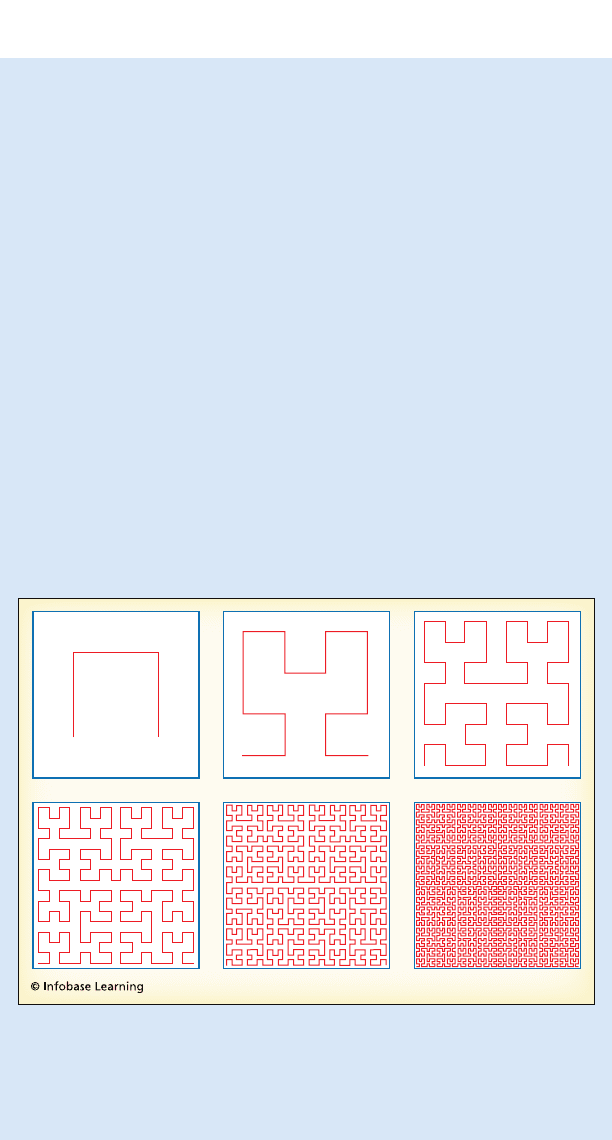Tabak J. Beyond Geometry: A New Mathematics of Space and Form
Подождите немного. Документ загружается.


40 BEYOND GEOMETRY
they considered. Instead, they simply demonstrated that a given
infinite set could be placed in one-to-one correspondence with a
proper subset of itself.)
Cantor soon demonstrated that he could place the set of natu-
ral numbers into a one-to-one correspondence with the set of all
rational numbers. This was surprising to many people at the time,
and many people are surprised by this result today. The reason is
that between any two distinct real numbers—no matter how close-
ly they are spaced—there are infinitely many rational numbers,
and between any two distinct real numbers—no matter how far
apart they are spaced—there are only finitely many natural num-
bers. Nevertheless, the set of rational numbers is no larger than
the set of natural numbers, Cantor also discovered that there are
even larger-looking sets than the set of rational numbers that can
be placed in one-to-one correspondence with the set of natural
numbers. The set of algebraic numbers, for example, is the set of all
numbers that are roots of polynomials with rational coefficients.
(Or to put it another way: An algebraic number is a solution to an
equation of the form a
n
x
n
+ a
n − 1
x
n − 1
+ . . . + a
1
x + a
0
= 0, where
all the numbers a
0
, a
1
, a
2
, . . . , a
n
are rational numbers.) The set of
algebraic numbers contains the set of rational numbers as a proper
subset. It also contains many irrational numbers, but it, too, can be
placed in one-to-one correspondence with the set of natural num-
bers. (Any set that can be placed in one-to-one correspondence
with the set of natural numbers is called a countable set.)
When Galileo was faced with the “paradox of the infinite,” he
had speculated that the terms less than, greater than, and equal to did
not apply to infinite sets, but Cantor showed that this speculation
was false. While many different-looking sets are the same size,
some sets cannot be placed in one-to-one correspondence with the
set of natural numbers. Cantor showed, for example, that the set
of real numbers is definitely larger than the set of natural numbers
because the assumption that a one-to-one correspondence exists
between these two sets leads to a logical contradiction.
To better appreciate what Cantor discovered, consider the so-
called power set. Given a set S, the power set of S, which is often
denoted by the symbol 2
S
, consists of all the subsets of S. To take a
finite example, let S = {a, b, c}. The power set of S is {{a, b, c}, {a, b},

A New Mathematical Landscape 41
{a, c}, {b, c}, {a}, {b}, {c}, ∅}, where the symbol ∅ denotes the empty
set, the set consisting of no elements. (The empty set is always
assumed to be a subset of every set.) Notice that in our example,
the set S has three elements, and the power set of S has eight ele-
ments, and 8 = 2
3
. For any finite set S, the number of elements in
S is always 2
S
, which denotes the number 2 raised to the power
of the number of elements in S. The notation is simply carried
over to infinite sets. What Cantor discovered is that no matter
whether the set is finite or infinite, the power set of a set can never
be placed in one-to-one correspondence with the original set. In
particular, the power set of the natural numbers is too large to be
placed in one-to-one correspondence with the set of natural num-
bers. Instead, it can be placed in one-to-one correspondence with
the set of all real numbers. Similarly, the set of all real numbers
cannot be placed in one-to-one correspondence with the power
set of the set of real numbers. The power set of the set of real
numbers is, therefore, strictly larger than the set of real numbers.
To bring some order to his many discoveries, Cantor created
a set of symbols to represent different “sizes” of infinity. Any
set that could be placed in one-to-one correspondence with the
natural numbers was said to have cardinality ℵ
0
. (The symbol ℵ
is pronounced “aleph,” and the word “cardinality” we can take
to mean “number of elements.”) Every countable set, therefore,
has cardinality ℵ
0
. Any set that can be placed in one-to-one cor-
respondence with the power set of the natural numbers is said to
have cardinality ℵ
1
; any set that can be placed in one-to-one cor-
respondence with the “power set of the power set” of the natural
numbers is said to have cardinality ℵ
2
, and so on. These symbols
are called transfinite numbers, and Cantor even created a trans-
finite arithmetic. (Given two sets, A and B, suppose we know the
cardinality of A and the cardinality of B, then Cantor’s transfinite
arithmetic enables us to compute the cardinality of the set formed
by, for example, the union of A and B.)
What was more surprising to Cantor was that the dimen-
sion of a set seemed to play no role with respect to its size.
As Cantor became increasingly adept at imagining one-to-one
correspondences, he discovered a one-to-one correspondence
between the points on the unit interval—this is the set {x: 0 ≤ x

42 BEYOND GEOMETRY
≤ 1}—and the points in the unit square, which is the square with
the unit interval as base—in other words, {(x, y): 0 ≤ x ≤ 1, 0 ≤ y ≤
1}. (To be clear: The unit square is the boundary of the square and
every point inside the boundary of the square.) The existence
of such a correspondence was a shock. Cantor initially took it
as “obvious” that the set of points in the unit square could not
possibly be placed in one-to-one correspondence with the set of
points on the unit interval. It seemed to Cantor, as it seems to
many people today, that the dimensions of the two sets should
affect the sizes of the sets. One can picture a unit square as con-
sisting of infinitely many “vertical” copies of the unit interval,
in the sense that above each point x in the unit interval, there
is (within the unit square) a unit interval with x as an endpoint.
In fact, the union of all such intervals is the unit square, and yet
Cantor proved that there are no more points in the unit square
than there are in the unit interval. (One way of thinking about
this discovery is that it contradicts Euclid’s fifth axiom, “The
whole is greater than the part.”)
Cantor went further, discovering a one-to-one correspondence
between points in the unit interval and points in the unit cube,
which is the term for a cube with edges one unit long. He even
discovered a one-to-one correspondence between the unit inter-
val and the unit “hypercube,” which is a cube in n-dimensional
space, where n is any integer greater than three. He wrote a letter
describing his discovery to his friend Richard Dedekind, and it is
in that letter that he wrote, “I see it but I don’t believe it!” His new
results, Cantor believed, were calling into question fundamental
ideas about the concept of dimension. What did it mean to say
that a figure is n-dimensional when the points that constituted
the figure could be placed in one-to-one correspondence with an
m-dimensional figure, where m is different from n?
Dedekind speculated that the key to understanding dimension
required the concept of continuity. It was not enough, he believed,
that the correspondence be one-to-one, it must also be continu-
ous. In a letter to Cantor, Dedekind wrote that every one-to-one
correspondence between sets of different dimensions must be
discontinuous. This is easier said than proved, however, and nei-

A New Mathematical Landscape 43
ther Cantor nor Dedekind was able to prove Dedekind’s hypoth-
esis. The situation became cloudier still when the mathematician
Giuseppe Peano discovered his continuous space-filling curve (See
the sidebar “Peano’s Space-Filling Curve”).
Even so, infinite sets of points have other properties besides
their cardinality, and there are things to discover besides corre-
spondences. Cantor soon turned his attention to some of these
other properties. Sets can, for example, be distinguished by the
way they are distributed in “space.” Compare, again, the set of
natural numbers with the set of rational numbers. It is always
possible to draw a circle containing a given natural number in its
interior with the additional property that no other natural number
belongs to the interior of the circle. In a sense, therefore, natural
numbers are “isolated” from each other.
By way of contrast, if we draw a small circle centered about any
point on the real line, that circle will always contain infinitely
many rational numbers. This is true no matter how small we make
the circle and no matter which point we choose as the center of
the circle. (Dedekind made indirect use of this property when he
showed that the set of real numbers has the same continuity as the
line.) Although the set of natural numbers and the set of rational
numbers have the same cardinality, the ways they are distributed
along the line are very different.
Other possibilities exist. Consider, for example, the set S
= {1,
1
⁄
2
,
1
⁄
3
, . . .}. This set can also be placed in one-to-one
correspondence with the set of natural numbers using the follow-
ing function: f(n) =
1
⁄
n
. As with the natural numbers, every number
in the set S is “isolated” from every other number in S in the sense
that no matter which element of S we choose, we can draw a circle
that contains that number in its interior and such that no other
number in S belongs to the interior of our circle. But the number
zero, which does not belong to S, has a very different property:
Every circle that contains zero in its interior contains infinitely
many elements of the set S. The distribution of the elements
of S is very different from the distribution of the set of natural
numbers, and it is also very different from the distribution of the
set of rational numbers.

44 BEYOND GEOMETRY
counterexample 3: peano’s
space-filling curve
As mathematicians sought to phrase their mathematical ideas in ever
more rigorous language, they discovered many “pathological functions,”
which is the name they gave to the functions that violated their common
sense notions of what a function should be. The existence of pathologi-
cal functions indicated that the logical implications of certain simply stat-
ed concepts could be both subtle and counterintuitive. One of the most
famous of these pathological functions was discovered by the Italian
mathematician and logician Giuseppe Peano (1858–1932). Roughly
speaking, it provided a counterexample to the idea that the graph of a
continuous function defined on an interval should “look like” a curve.
To appreciate Peano’s curve, it is important to recall the way that func-
tions are first introduced in an elementary algebra class. A function is
defined as a set of ordered pairs with a particular property. Recall that
the first element in the ordered pair belongs to a set called the domain,
and the second element in the ordered pair belongs to a set called the
range. In order that a set of ordered pairs determine a function, it is only
Diagram showing the process by which Peano’s curve is generated. At
each step, the square is divided into finer “cells,” and then the pattern
is repeated within each cell. In the limit, the process generates a curve
that passes through each point in the unit square at least once.

A New Mathematical Landscape 45
necessary that each element in the domain occur exactly once among
the set of all ordered pairs that make up the function. The domain and
the range can be sets of any type. In Peano’s case, the domain is the
unit interval {t: 0 ≤ t ≤ 1}, and the range is the unit square {(x, y): 0 ≤ x
≤ 1; 0 ≤ y ≤ 1}. (We use t instead of x in describing the unit interval just
to avoid any possible confusion between the two sets.) Consequently,
if we were to write one of the ordered pairs that belongs to Peano’s
function, it would look like this: (t, (x, y)). The number t belongs to the
domain, and the ordered pair (x, y) belongs to the range. What drew
the attention of researchers around the world to Peano’s function—and it
is a function according to our definition—is that it satisfied the following
two criteria: (1) Every point in the unit square occurs at least once in the
set of all ordered pairs that make up the function, and (2) the function
is continuous. Geometrically speaking, therefore, Peano succeeded in
continuously “deforming” the unit interval until it covered the unit square.
(Peano’s space-filling curve does not pass the so-called vertical line test,
the test students learn in high school algebra courses, but the vertical
line test applies only to functions in which the domain is a subset of the
real numbers and the range is also a subset of the real numbers.)
Peano’s curve called into question the concept of dimension. For a
long time, mathematicians had naively accepted the idea that the dimen-
sion of the square was different from the dimension of the line because
they had always used two numbers—the x and y coordinates—to iden-
tify a point in the square, and they only used one number to identify a
point in the interval. However, Peano’s curve could be interpreted as a
scheme for identifying every point (x, y) in the unit square with a single
“coordinate,” its t-coordinate, where t is the point in the domain that is
paired with (x, y) by Peano’s function, and unlike Cantor’s correspon-
dence between the interval and the square, Peano’s curve is continuous.
Here are two additional facts about Peano’s curve: (1) It passes
through some points in the square more than once, so, in contrast to
Cantor’s correspondence, Peano’s curve is not a one-to-one correspon-
dence, and (2) the curve does not pass through any point in the square
more than finitely many times. This raises the question of whether it can
be refined so as to make it a continuous one-to-one correspondence.
Peano’s curve has been studied intensively in the century since its
discovery. It is now known that every continuous function with domain
equal to the unit interval and range equal to the unit square must pass
through some points of the square at least three times. Cantor’s one-to-
one correspondence between the unit square and the unit interval can,
therefore, never be refined in such a way that it becomes a continuous
one-to-one correspondence. Peano’s discovery also inspired research
into what would soon become a branch of set-theoretic topology called
dimension theory. (Dimension theory is discussed in chapter 7.)

46 BEYOND GEOMETRY
Faced with a rich collection of examples, Cantor began to search
for unifying concepts. He developed a vocabulary that would
enable him to describe the extraordinarily rich mathematical land-
scape that he had uncovered. A term (and a concept) that is of spe-
cial importance to set-theoretic topology is the term open set. To
understand the idea of an open set—and we will use the term often
in what follows—suppose that we are given a set S and a point x
that belongs to S. (To be specific, suppose that S is a subset of the
real line or of the plane.) The point x is called an interior point of S
if we can draw a small circle centered about x such that only points
of S belong to the interior of the circle. In other words, a point x
in S is an interior point of S provided that every point that is close
to x also belongs to S.
Consider, for example, this subset of the real line: {x: 0 < x <
1}. It is an example of an open set. To see why this is true, choose
any point belonging to this set, and you will see that it is possible
to draw a circle containing the point with the additional property
that all points within the circle also belong to {x: 0 < x < 1}. By
contrast, the set {x: 0 ≤ x ≤ 1} is not open. Why? If we draw a
circle about 1, for example, the circle will contain numbers that
are greater than 1, and these numbers do not belong to {x: 0 ≤ x
≤ 1}. This is true no matter how small the circle is drawn. Similar
reasoning shows that any circle, no matter how small, when drawn
about 0, will contain numbers that are not elements of {x: 0 ≤ x ≤
1}. (Notice, however, that the set of all real numbers that do not
belong to {x: 0 ≤ x ≤ 1} is an open set. This is, in fact, how a closed
set is defined: If S is an open set, then the set of all elements not
belonging to S is a closed set.)
Cantor also used the idea of a limit point, another notion that is
central to topology. Given a set S, a point x is called a limit point
of S whenever every open set containing x also contains points of
S different from x. The point x may or may not belong to S. The
following are five examples of the idea of limit point:
Example 3.1: Dedekind’s construction, which is described in the
section Richard Dedekind and the Continuum, showed that every
real number is a limit point of the set of rational numbers.

A New Mathematical Landscape 47
Example 3.2: The set of limit points of {x: 0 < x < 1} is the set {x: 0
≤ x ≤ 1}. (To see why, notice that any circle drawn about any point
in {x: 0 ≤ x ≤ 1} will contain points belonging to {x: 0 < x < 1}, so
every point in {x: 0 ≤ x ≤ 1} is a limit point of {x: 0 < x < 1}. On
the other hand, choose a point x that is not in {x: 0 ≤ x ≤ 1}. It is
always possible to draw a circle about x that does not contain any
point in {x: 0 < x < 1}. Therefore, no point outside of {x: 0 ≤ x ≤
1} is a limit point of {x: 0 < x < 1}.)
Example 3.3: The set of limit points of {x: 0 ≤ x ≤ 1} is {x: 0 ≤
x ≤ 1}. (The proof is similar to that of the preceding example.)
Example 3.4: The set of limit points of {1,
1
⁄
2
,
1
⁄
3
, . . .} is the set
consisting of the number 0. (Any circle that extends r units to
the right of zero will contain every number of the form
1
⁄
n
, where
n is greater than
1
⁄
r
.)
Example 3.5: The set of limit points of the set of natural num
-
bers is the empty set.
Cantor was a pioneer. He saw further than his contemporaries.
Although some very prominent mathematicians of Cantor’s time
opposed his work because they found his ideas to be so foreign,
today many of those mathematicians are remembered principally
for their opposition to Cantor. Meanwhile, Cantor’s insights have
become central to mathematical thought in general and topology
in particular.
Different-Looking Sets, Similar Properties: Part I
When Cantor discussed sets of “points,” it seems clear, at least in
retrospect, that he usually meant points on a line or points in a
plane or points in three-dimensional space—in other words, geo-
metric points, but many sets, even many mathematical sets, have
nothing at all to do with geometry in the usual sense. We can form
sets of functions, or sets of letters, for example, and purely as a
matter of convention we can call the elements in these sets “points.”
Furthermore, we can take subsets of these sets, and if (somehow)
HOM BeyondGeom-dummy.indd 47 3/29/11 4:21 PM

48 BEYOND GEOMETRY
we can find a way to define what it means for a point to be an inte-
rior point of a subset, then we can talk about open sets, closed sets,
limit points, and a host of other related notions. We can, in effect,
divorce the notion of point from any geometric interpretation, and
this is exactly what happened.
One interesting generalization of the concept of point can be
found in the work of the Italian mathematician Giulio Ascoli (1843–
96). To better appreciate Ascoli’s idea, we begin with the work of the
German mathematician Karl Weierstrass (1815–97). Weierstrass
began his time in college as an indifferent student at the University
of Bonn, where he had planned to study law. He eventually gradu-
ated from the Academy of Münster and began his working life as a
schoolteacher, and it was as a schoolteacher that he worked for the
next 14 years. It was also during this time that Weierstrass became
obsessed with the concept of rigor in analysis. Working in isolation,
he attempted to place analysis on a firm logical footing, something
it had lacked since the days of Leibniz and Newton. He eventually
published some of his ideas in Journal für die reine and angewandte
Mathematik (Journal for Pure and Applied Mathematics), an important
research publication, and not long after that he was awarded an hon-
orary doctorate by the University of Königsberg. Later, he found a
position at the Royal Polytechnic School in Berlin. Weierstrass’s
example of a continuous nowhere differentiable function was the
first such example to become widely known, although Bolzano was
the first to conceive of such a function, and today Weierstrass is
often called the “father of modern analysis.”
The discovery of Weierstrass that is most relevant to this chap-
ter concerns the existence of limit points for bounded infinite sub-
sets of points in the plane. (A subset of the plane is bounded if one
can draw a circle about the set so that all the points lie inside the
circle. So, for example, the unit square is a bounded set, but the
set {(n, 0), n = 1, 2, 3, . . . ,} is not bounded.) Today, Weierstrass’s
discovery is usually stated for n-dimensional spaces, where n can
represent any natural number, but in 1865, when Weierstrass orig-
inally revealed his discovery, he stated it in terms of sets of points
in the plane. His theorem: “Every infinite bounded subset of the
plane has a limit point.” In other words, if S is any subset of the

A New Mathematical Landscape 49
plane that is bounded and contains infinitely many points, there
is a point in the plane, which we will call P—and P may or may
not belong to S—such that P is a limit point of S. This theorem,
generalized to n-dimensional spaces, is now called the Bolzano-
Weierstrass theorem.
Returning to Ascoli, in 1884, he published a paper in which he
considered a set of functions defined on the closed interval: {x: a ≤
x ≤ b}. These functions satisfied the following criteria:
• They are real-valued. (A function is “real-valued” if its
range is some subset of the real numbers.)
• They are equicontinuous. (Equicontinuity is a concept
that applies to sets of continuous functions. A set of
functions is equicontinuous if, given a positive num-
ber, which we will call ε, there exists another positive
number, which we will call δ, such that whenever the
distance between x
1
and x
2
is less than δ, the distance
between f(x
1
) and f(x
2
) will be less than ε and the same
δ and ε will work for every pair of points x
1
and x
2
in the
domain and for every function f in the set.)
Let I represent the set of all equicontinuous real-valued func-
tions on {x: a ≤ x ≤ b}. One way of understanding Ascoli’s theorem
is that it takes the Bolzano-Weierstrass theorem and applies it to
I. The set I corresponds to the plane in the Bolzano-Weierstrass
theorem, and the “points” of I are equicontinuous functions.
To continue with the analogy between the plane and the set I,
Ascoli needed a way to determine the distance between two points
of I. He defined the distance between two functions in I as the
maximum (vertical) distance between their graphs. Having defined
the distance between two functions, Ascoli could “draw a circle”
about each point in I. Let g be a point—that is, a function—that
belongs to I. By “a circle centered at g,” we mean a subset of I of
the form { f: −M ≤ g(x) − f(x) ≤ M} for some positive number M.
Each such M determines a “circle” centered at g, where M is, in
effect, the radius of the circle. Let S represent an infinite subset
